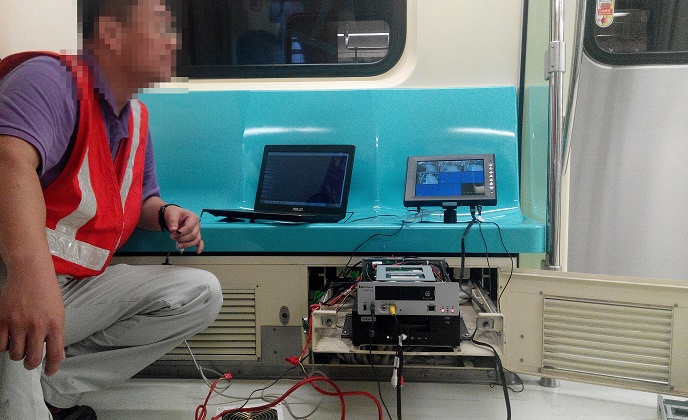The Taipei Rapid Transit Corporation (TRTC) operates the Taipei Metro System, providing reliable transportation service to residents and visitors of metropolitan Taipei for their daily commute. The Taipei Metro system currently consists of five main lines: the Wenhu line, Tamsui-Xinyi line, Songshan-Xindian line, Zhonghe-Xinlu line and Bannan line.
The Taipei Rapid Transit Corporation (TRTC) operates the Taipei Metro System, providing reliable transportation service to residents and visitors of metropolitan Taipei for their daily commute. The Taipei Metro system currently consists of five main lines: the Wenhu line, Tamsui-Xinyi line, Songshan-Xindian line, Zhonghe-Xinlu line and Bannan line.
The MRT system has been equipped with a total of 130 EverFocus mobile DVRs (MDVRs) that cover the whole route, including the Taoyuan Airport line which has not commenced operations yet, but excluding the Wenhu line.
To ensure the security and safety of the passengers, the surveillance system for the moving cabins needed to overcome certain challenges:
- Vibration: all hard disk drives (HDDs) have a self-protection mechanism which causes the reader to “unpark” when there is turbulence, causing write/read errors. Hence, a well-designed anti-vibration feature in both the hardware and firmware is very important to enhance its stability.
- Cable connection: normal BNC connectors are not ideal for train systems as the connection can easily fall out and affect signal transmission.
- Cabling distance: each cabin is about 70 meters wide, with a total length of about 500 meters, making it a challenge for installers to ensure that the signal remains unchanged all the way to the MDVR.
Aside from these basic requirements, the mobile surveillance system also had to allow for the following conditions:
- Integration with various train/tram auto control systems (i.e., the TRTC uses the Kawasaki system, while the Taoyuan MRT uses the Siemens system).
- Integration of the station with the train/tram. Mobile surveillance systems rely on 3G, 4G and Wi-Fi connection rather than regular internet service.
- Analysis of big data/IVS gathered by various sensors or cameras such as GPS, 3- axis G-sensors, facial recognition, people counting, monitoring of unattended luggage, etc. All of which needed to be integrated together with the video stream.
- Analysis of driving behavior
Due to the abovementioned challenges, several special requirements were necessary:
- Anti-vibration certificates: EN50155/EN60173
- Safety certificates: EMI/EMC pass
- M12 connector to protect the signal source
- Integration of the emergency aid system and broadcasting system on the train and with the station, as well as integration of metadata with the video stream.
 The engineer is performing a field test on the EverFocus mobile
The engineer is performing a field test on the EverFocus mobile
system for a cabin on the Taipei Metro System.
EverFocus xFleet Mobile Surveillance Solution
The EverFocus mobile surveillance solution went beyond the basic requirements of the TRTC project, providing extra special features for various applications.
The EverFocus xFleet is a unique CMS that is specially designed for mobile surveillance solutions. The server-client structured XFleet is one of the few CMS that can successfully integrate video streams and metadata. Other features include:
- Support of different GPS systems, as evidenced by use cases such as the GLONASS in Russia and CIS area, Galileo in EU, and BDS in China.
- Driver behavior analysis: while the X/Y moving dimension is the key factor on trains, the Z (horizontal movement) moving dimension is more important on bus/BRT systems for driving behavior analysis.
Through flexible settings of the X/Y/Z value, users can set self-defined limits by which alerts/reports are sent to the station for driving behavior analysis and for officials to take corrective actions. This significantly enhances the safety and protection of the passengers (i.e., during speeding and rapid jumps) as well as cost savings (i.e., too many sudden breaks).
- On-board diagnosis (OBDII), CAN buses: data about vehicle health status, such as tire pressure, oil consumption, etc. and all the dashboard information, can serve as important evidence in court during traffic accident investigations.
- External sensors: thermal meters for special logistics fleet, NFC signal integration on school buses for access control, etc.
XFleet is a sophisticated solution that the station can leverage to manage moving vehicles/fleet. Most station or fleet management is merely handled via a GPS box.
Secondly, the MDVRs are equipped with 3G/4G and Wi-Fi modules. Field testings with most of the major ISPs all over the world ensure signal transmission between the vehicle and the station.
Also, EN50155/60173 certifications met most of the train’s anti-vibration requirements. Moreover, SAE J1455 standards guarantees that the system is capable of meeting the demands for harsh environments commonly associated with bus/BRT systems.
Finally, the “Event to SD card” design and the external 2nd storage device (HDD/SSD/USB-interfaced storage) are protected by fire/explosion-proof metal cases, securing the video footage even during violent shocks or car crashes.